第二章 细胞基本知识概要 细胞生物学
- 格式:doc
- 大小:37.00 KB
- 文档页数:4
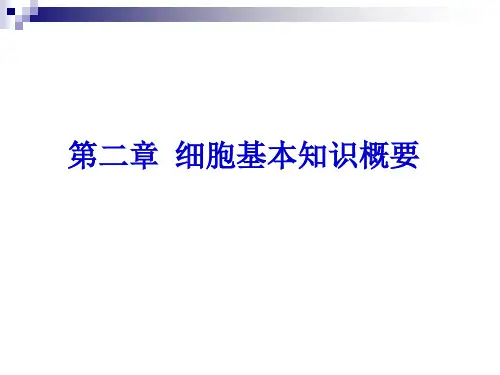
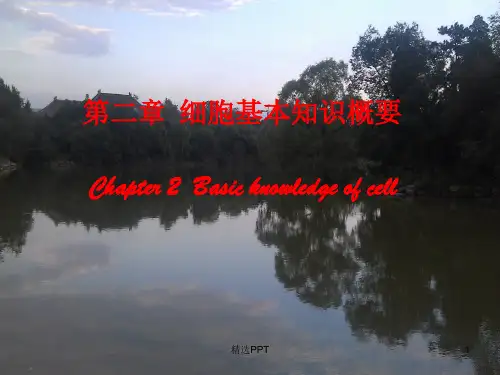
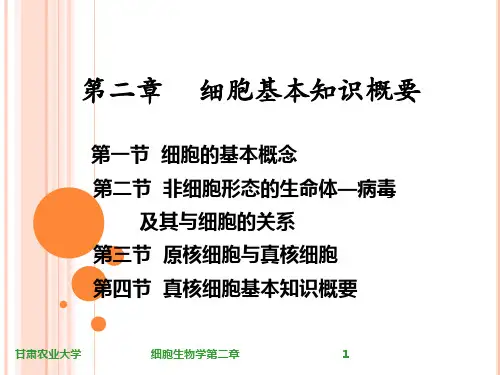

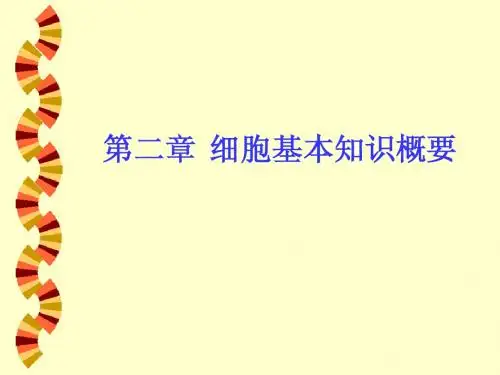
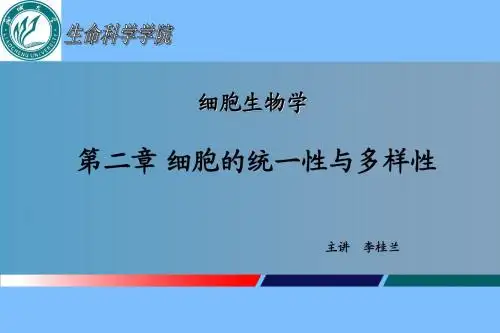
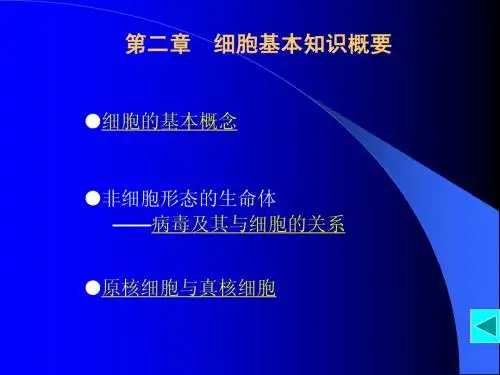
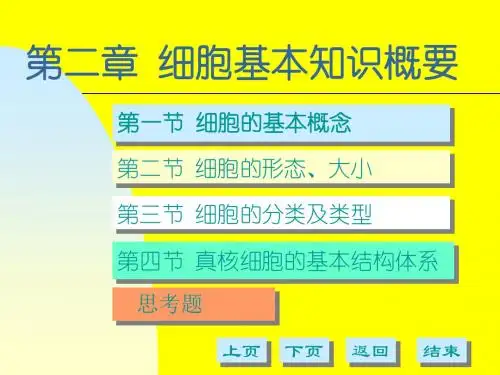
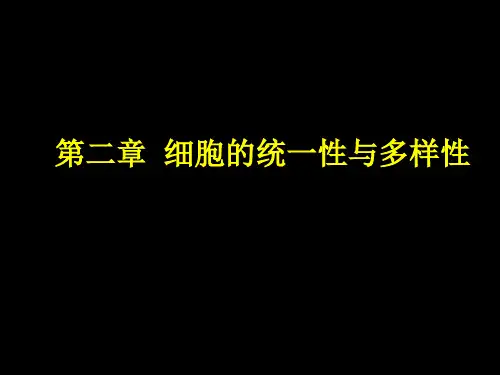
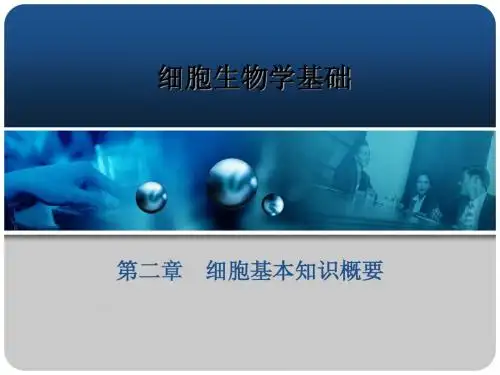
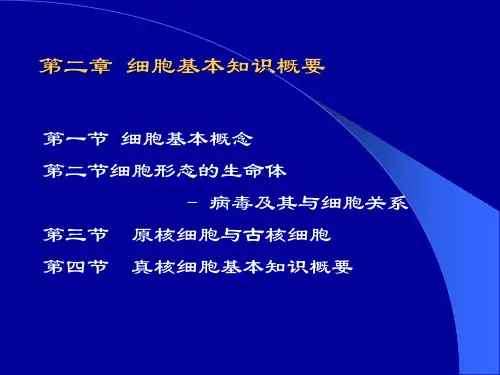
名词解释第一章绪论1.细胞生物学:是研究细胞基本生命活动规律的科学,是在显微、亚显微和分子水平上,以研究细胞结构与功能,细胞增殖、分化、衰老与凋亡,细胞信号传递,真核细胞基因表达与调控,细胞起源与进化等为主要内容的一门学科。
2、显微结构:在普通光学显微镜中能够观察到的细胞结构,直径大于0.2微米3、亚显微结构:在电子显微镜中能够观察到的细胞分子水平以上的结构,直径小于0.2微米.第二章细胞基本知识概要1.细胞学:研究细胞形态、结构、功能和生活史的科学.2.细胞:由膜转围成的、能进行独立繁殖的最小原生质团,是生物体电基本的开矿结构和生理功能单位。
3.病毒:迄今发现的最小的、最简单的专性活细胞内寄生的非胞生物体,是仅由一种核酸(DNA或RNA)和蛋白质构成的核酸蛋白质复合体。
4.原核细胞:没有由膜围成的明确的细胞核、体积小、结构简单、进化地位原始的细胞。
第四章细胞膜与细胞表面1.生物膜:把细胞所有膜相结构称为生物膜。
2.细胞外被:又称糖萼,细胞膜外表面覆盖的一层粘多糖物质,实际上是细胞表面与质膜中的蛋白或脂类分子共价结合的寡糖链,是膜正常的结构组分,对膜蛋白起保护作用,在细胞识别中起重要作用。
3.细胞连接:细胞连接是多细胞有机体中相邻细胞之间通过细胞膜相互联系、协同作用的重要组织方式,在结构上常包括质膜下、质膜及质膜外细胞间几个部分,对于维持组织的完整性非常重要,有的还具有细胞通讯作用。
4紧密连接:紧密连接是封闭连接的主要形式,普遍存在于脊椎动物体表及体内各种腔道和腺体上皮细胞之间。
是指相邻细胞质膜直接紧密地连接在一起,能阻止溶液中的分子特别是大分子沿着细胞间的缝隙渗入体内,维持细胞一个稳定的内环境。
5.间隙连接:是动物细胞间最普遍的细胞连接,是在相互接触的细胞之间建立的有孔道的连接结构,允许无机离子及水溶性小分子物质从中通过,从而沟通细胞达到代谢与功能的统一。
6.细胞粘附分子:细胞粘附分子是细胞表面分子,多为糖蛋白,是一类介导细胞之间、细胞与细胞外基质之间粘附作用的膜表面糖蛋白。
第二章细胞基本知识概要本章内容提要:第一节细胞的基本概念第二节非细胞形态的生命体-------病毒及其与细胞的关系第三节原核细胞与古核细胞第四节真核细胞基本知识概要第一节细胞的基本概念What is a cell?Cells are structural units that make up plants and animals, also there many single cell organisms. What cells all have in common is they are small 'sacks' composed mostly of water. The 'sacks' are made from a phospholipid bilayer. The membrane is semi-permeable (allowing some things to pass in or out of the cell and blocking others), there are also other methods of transport that we will get into later.So what is in a cell? The cell as we mentioned is a fluid like membrane that surrounds the contents of the cell. Each component will be discussed in more detail later.一、细胞是生命活动的基本单位1、一切有机体都由细胞构成,细胞是构成有机体的基本单位;2、细胞具有独立的、有序的自控代谢体系,细胞是代谢与功能的基本单位3、细胞是有机体生长与发育的基础4、细胞是遗传的基本单位,细胞具有遗传的全能性5、没有细胞就没有完整的生命二、细胞的基本共性1.所有的细胞表面均有由磷脂双分子层与镶嵌蛋白质构成的生物膜,即细胞膜。
2.所有的细胞都含有两种核酸:即DNA与RNA作为遗传信息复制与转录的载体。
3.作为蛋白质合成的机器─核糖体,毫无例外地存在于一切细胞内。
4.所有细胞的增殖都以一分为二的方式进行分裂。
第二节非细胞形态的生命体—病毒及其与细胞的关系一、Basic characteristics of virusesSimply stated, viruses are merely genetic information surrounded by a protein coat. They may contain external structures and a membrane. Viruses are obligate(专性的)intracellular parasites--meaning that they require host cells to reproduce.In the viral life cycle, a virus infects a cell, allowing the viral genetic information to direct the synthesis of new virus particles by the cell.There are many kinds of viruses. Those infecting humans include polio(脊髓灰质炎), influenza, herpes (疱疹), and human immunodeficiency virus (HIV) causing AIDS.二、viral reproduction(i.e. the course of viral infection, e.g. HIV infection)1、Attachment(getting in)On the surface membrane of all livingcells are complex protein structures called"receptors". A receptor is often compared toa lock into which a specific key or "ligand" will fit. There are at least two receptors on T-lymphocytes to which the human immunodeficiency virus (HIV) sticks. The primary receptor, called "CD4", is shown on the right in the diagram. But a second receptor that loops through the cell membrane 7 times is critical forinfection to occur.HIV infection of a lymphocyte requires attachment of the virus to the cell membrane through both of these "ligand-receptor" links. In cells whose "7-transmembrane receptor" is different, the HIV "key" no longer matches the lymphocyte "lock" and attachment is incomplete. Those cells may avoid infection by HIV. Tight attachment of the viral particle to receptors on the lymphocyte membrane enables fusion with the cell membrane. The viral contents, including viral RNA (shown in yellow) then empty into the cell's cytoplasm.Like other viruses that infect human cells, HIV commandeers the host's machinery to make multiple copies of itself.2、Reverse Transcription: Converting viral RNA into DNAAn enzyme (protein) that's part of the human immunodeficiency virus reads the sequence of viral RNA nucleic acids that have entered the host cell and transcribes the sequence into a complementary DNA sequence. That enzyme is called "reverse transcriptase" . Without reverse transcriptase, the viral genome couldn't become incorporated into the host cell, and couldn't reproduce.Reverse transcriptase sometimes makes mistakes reading the RNA sequence. The result is that not all viruses produced in a single infected cell are alike.3、Integration of Viral DNAOnce the viral RNA has been reverse-transcribed into a strand of DNA, the DNA can then be integrated (inserted) into the DNA of the lymphocyte. The virus has its own enzyme called "integrase" that facilitates incorporation of the viral DNA into the host cells DNA. The integrated DNA is called a provirus.4、Transcription: Back to RNAAs long as the lymphocyte is not activated or "turned-on", nothing happens to the viral DNA. But if the lymphocyte is activated, transcription of the viral DNA begins, resulting in the production of multiple copies of viral RNA. This RNA codes for the production of the viral proteins and enzymes (translation) and will also be packaged later as new viruses.5、Translation: RNA -> ProteinsThere are only 9 genes in the HIV RNA. Those genes have the code necessary to produce structural proteins such as the viral envelope and core plus enzymes like reverse transcriptase, integrase, and a crucial enzyme called a protease.6、Viral ProteaseWhen viral RNA is translated into a polypeptide sequence, that sequence is assembled in a long chain that includes several individual proteins (reverse transcriptase, protease, integrase). Before these enzymes become functional, they must be cut from the longer polypeptide chain. Viral protease cuts the long chain into its individual enzyme components which then facilitate the production of new viruses.7、Assembly and Budding (release)Finally, viral RNA and associated proteins are packaged and released from the lymphocyte surface, taking with them a swatch(样品, 样本)of lymphocyte membrane containing viral surface proteins. These proteins will then bind to the receptors on other immune cells, facilitating continued infection.Budding viruses are often exactly like the original particle that initially infected the host. In the case of HIV, however, the resulting viruses exhibit a range of variations which makes treatment difficult.三、病毒与细胞在起源与进化中的关系病毒是非细胞形态的生命体,它的主要生命活动必须要在细胞内实现。